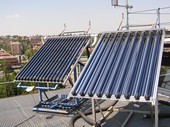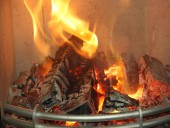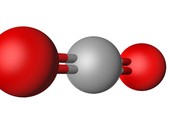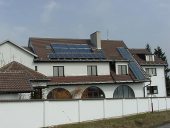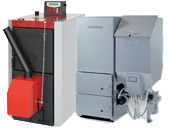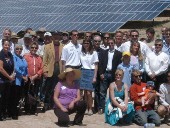Representatives of business, government, international institutions, industry and research, presented on the conference their vision and practical steps to reduce consumption and protect the climate.
Archiv článků od 19.3.2012 do 22.6.2012
This paper examines the process of burning piece of wood in the low power fireplace (units to tens of kW). This combustion process is cyclical and what users are most interested in the combustion device, the frequency of fuel to the fire. The paper defines the basic concepts such as burn-up curve and the burn rate that have close relationship to the rate of reloading.
The biodegradable waste is commonly contained in solid household waste. Its amount is not neglected and its value is great for reusing, so it is necessary to determine suitable systems for dealing with this specific component. The hydraulic piping system helps to solve questions about collection, sorting and transport this type of waste. The paper introduces systems for transport biodegradable waste and speaks about their advantages, disadvantages and areas of their suitable using.
Greenpeace International, in collaboration with the European Renewable Energy Council (EREC) prepared a plan for future energy development across the EU. The proposal is aimed at minimizing the energy dependence on unstable regions in particular. The core concept of energy by Greenpeace and EREC is to maximize the effective use of primary energy sources. For this reason, it is anticipated a gradual increase in the share of renewable sources.
Solar laboratory (SOLAB) has been built at Department of Environmental Engineering, Faculty of Mechanical Engineering Czech Technical University in Prague for solar thermal collectors testing in education and research activities. SOLAB provides the test of thermal performance, incidence angle modifier (optical characterization of collector) and time constant.
The assessment is a comparison of hot water production using photovoltaic devices in combination with a small heat pump and conventional solar thermal collectors. Research shows that with the same areas of the collectors, investment cost are similar, but a variant of solar electricity with small heat pump can save significantly more energy.
Construction of straw often attracts a supporter of natural building, however we encounter a critical rejection of orthodox among builders. Post of architect Aleš Brotánek analyzes using straw in facades of wooden buildings, which seems to be questionable at present. It defends its environmental advantages, but also a convenient fire resistance of over 120 minutes due to protection (external and internal) non-flammable layers of clay and a thickness of 50 mm and lime plaster thickness of 30 mm. The application of straw is accompanied by practical examples, including installation.
The essence of the combustion process is burning fuel. This is a phenomenon that the authors clearly and wittily likened to the relationship of man and woman. At the same time in the article they explain in detail the technical terminology such as calorific value, combustion heat, humidity of wooden fuel, and the efficiency of common and condensing boilers.
At a European level a Directive of the European Parliament and Council 2010/31/EU on the energy performance of buildings (EPBD) has been released in 2010 whereas the main requirement is to reduce energy consumption in buildings (replacing 2002/91/EC). A set of European standards have been issued for its implementation, eg EN 15232 Energy performance of buildings - Impact of automation, control and management of buildings. In the Czech Republic the Directive was implemented by Act No. 406/2000 Coll. energy management and decree 148/2007 on the energy performance of buildings. The current global trend is characterized by promoting energy efficient technologies. The aim of this work is to summarize domestic household consumption, it´s prediction and analysis of potential energy savings by using the wiring system (BACS).
Currently carbon dioxide is commonly referred to as a difficult waste, which must be disposed in some way. The methods of disposal are often questionable (eg CCS) associated with high costs and uncertain effect. A rational approach in line with modern trends, however, is trying to use it as raw material. Overview of the technical possibilities of carbon dioxide utilization is presented.
Christian churches use a slightly different terminology than the general population. Instead of protection of the environment they are talking about protection of God's creation. From their perspective, the topic is not ecological but theological. In the context of renewable energy sources social aspects are much more accented.
Less experienced operating managers in the branch of mechanical services of building can easily get difficulty in identifying the causes of technical problems, which sometimes a common practice brings. The article gives a table of causes and effects of defects and disorders related to cooling and heat sources.
The paper is focused on general description of boilers and their basic classification on the basis of using fuels and main design differences. There are mentioned general descriptions and parameters of particular sorts of boilers. There is put the most emphasis on water tube boilers for combustion of solid fuel and description of grate systems.
The amount of volume coefficient depends on elevation of location of gas consumption and the temperature of gas flowing through the gasometer. In this paper we describe the procedure by which you can check that the coefficient of volume on the invoice is correct. The coefficient is one of the factors that affect your cost of gas.
At present, nobody knows how the energy future will look like. What is certain is that fossil resources can be depleted in the horizon of decades. Proven reserves of uranium – if the power consumption should be replaced by current reactors – would last for only a few years. There are only three promising energy technologies: nuclear fusion, fast breeder reactors with closed fuel cycle and renewable energy sources, along with energy efficiency. While commissioning of the first fusion power plant is expected the earliest by 2040, and demonstration plants with so-called generation IV reactors in 2030, renewable energy sources are already massively installed at present. Construction of nuclear power plant is always more expensive and takes more time than originally planned. Situation of renewables and especially photovoltaic is the reverse – they are built faster and the prices are lower than anyone imagined.
zpět na aktuální články



![Energy [R]evolution](/docu/clanky/0086/008673ou.jpg)
